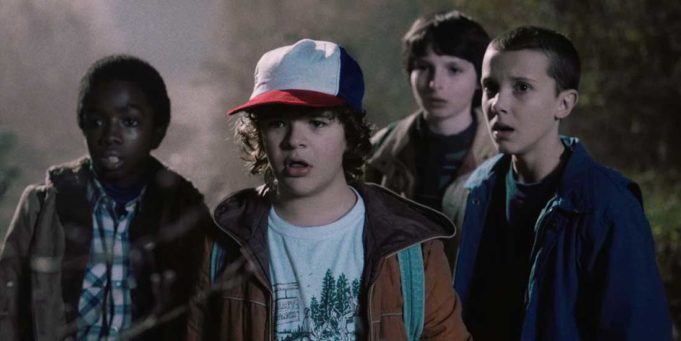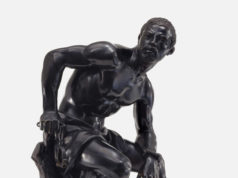As soon as fin-de-siècle technological innovation began to flourish – trains covering thousands of miles, photos in magazines and newspapers ushering the wide world into humble living rooms – artists began looking backward. Naturally. The century-long industrial revolution was a mindless, unforgiving, relentless lurch toward tomorrow, toward another long day in a poorly lit, obscenely poisonous factory churning out widgets for next-to-no pay. The future, the eternal unknowable, essentially forced artists (not the richest bunch, historically) to hark back to simpler, gentler times. For comfort, yes, but also for some income. Even if just a little.
Arts and Crafts purveyors emphasized floral prints and other natural imagery – Ah, reminds us of the gardens and fields of our youth! – while the pre-Raphaelites returned to the undisturbed, traditionally beautiful domestic imagery of Quattrocento Italian art. Ah, reminds us of our old studies! Though the concept of nostalgia had been around for centuries, it arguably assumed the distinction of genre at the end of the machines’ march.
But one man’s lovely memory is another’s nausea-inducing flashback, which means that period art has often been more than imitation. Contemporary themes continually seem to find their ways into even prehistoric-based tales or imagery made today.
Not all the time anymore, though. New technology and ways of thinking have pushed some artistic manifestations of nostalgia into transcending mere homage or point of departure. For some contemporary artists, setting a piece in the past isn’t enough. Their art must appear to be from the past.
In the web-based series Star Trek Continues, the look and feel of episodic action TV circa 1966 is fetishistically recreated right down to the cheesy music, cardboard sets, interrogation room-quality lighting, formulaic plots, and melodramatic acting. Leon Bridges’ debut album, oozing with trebly yet layered sonics and lots of backing ooo-ing and aaa-ing, could be mistaken for a collection of unreleased tracks by Sam Cooke or Otis Redding – in 2014 in the abandoned warehouse (natch) where Coming Home was laid down, the “newest” piece of equipment (save for a single laptop) was from 1960.
Easily the hottest slice of totalizing trompe-l’œil is Stranger Things, a newish Netflix action show in which familiar, borderline famous imagery from ’80s TV and film, along with that decade’s most memorable clothes, architecture, music, and narrative clichés, appears to be more of a plot than the murky yet suspenseful narrative embroiling the main characters.
As with music, painting, architecture – basically, every artform except maybe dance – nostalgia is driving the imitation game. Perhaps the only thing better than buying a cozy blanket is making your own. The past also carries with it the imprimatur of quality. To survive from the ’60s – the 19’s or 18’s – an artwork has to be good. Slyly depositing your brand new TV show right in between The Shining and Stand by Me in the film library – or your album among “Sam Cooke” and “Otis Redding” on iTunes – is a way of appropriating not only the quality of yesterday’s cultural artifacts but also their quality control. I’m not saying there’s more junk now – I’d bet that a lot of what doesn’t go mainstream is better than what does. (There’s no reason the Burning Hotels, Calhoun, and The Orbans aren’t mainstream music gods while The Killers, Bright Eyes, and Wilco are.) I simply believe there’s more clutter now. One way to cut through all the noise is to trick the collective unconscious. Stranger Things feels as if you’ve seen it before. Coming Home feels as if you’ve heard it before. The Further Adventures of Sherlock Holmes feels as if you’ve read it before.
And isn’t feeling good more important now than ever? We have no God, no world war, no metanarrative of any kind, and even though terrorism strikes in our backyards every day, we are too distracted by feeling good to care to notice or take action. And in comes the nostalgia, enveloping us completely, carrying us away, dragging us down into the blue empyrean from which the only escape is cruel, bracing reality.
Before an elderly Staffordshire couple died around 2013, they lived among 17th-century furniture and accoutrements only. “On entering the house, it was like going back in time to the period of Shakespeare,” said Charles Hanson of Hanson Auctioneers, the decade-old British house that generated £160,000 from the sale of all of the lots, with 100 percent of the proceeds going toward an animal shelter at the consigner’s request. The husband and wife would not have been able to live in their chosen era without being able to create enough contemporary wealth to afford the antiques. While the couple’s identity has not been revealed, these folks probably weren’t goat farmers or blacksmiths. Or factory workers.
Fourteen million people watch Stranger Things every week when it’s in season. That’s a lot of people who either feel as if they suffered through the reign of Ronald Reagan in a past life or a bunch of regular Joes and Janes who merely want a respite from the painful, terroristic now. I’ll take a trick for a little treat any day.













Watching episode 5 tonight.